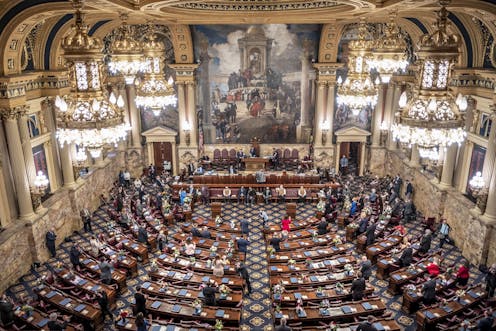Pennsylvania will keep its divided legislature thanks to split-ticket voters
- Written by Richardson Dilworth, Professor of Politics, Drexel University
 Democrats held on to their one-seat majority in the Pennsylvania House.Laurence Kesterson/AP
Democrats held on to their one-seat majority in the Pennsylvania House.Laurence Kesterson/APPennsylvania’s red shift in the 2024 election wasn’t isolated to the presidential race.
Statewide races for attorney general, auditor general and state treasurer all went to the Republican candidates, and the AP declared Republican David McCormick the winner against Democratic incumbent Bob Casey in the state’s U.S. Senate race – although the very tight margin, which could trigger an automatic recount.
Pennsylvania was and still is the swingiest of the swing states. In fact, going into the 2024 election, it was the only U.S. state to have a divided legislature. Republicans had a majority in the Senate, but Democrats held a one-vote majority in the House.
Surprisingly, the composition of the Pennsylvania General Assembly, including its split control, has remained largely the same after the 2024 voting.
As a Philadelphia-based political science professor who focuses on state and local politics, I believe Pennsylvania’s General Assembly remained so stable in the face of statewide electoral upheaval for three reasons: a lack of competitive state legislative districts, the small size of those districts and the fact that some Pennsylvania voters still vote for the representative and not the party despite the country’s stark political divide.
 Republican David McCormick, right, appears to have beaten three-term Democratic U.S. Sen. Bob Casey by about half of a percentage point.Matt Rourke/AP
Republican David McCormick, right, appears to have beaten three-term Democratic U.S. Sen. Bob Casey by about half of a percentage point.Matt Rourke/APSlight churn in PA Senate
Let’s look at the light churn in the state Senate first.
Democrat Patty Kim won the 15th Senate district in Dauphin County, which had previously been held by a Republican who retired.
Meanwhile, 29-year-old Republican challenger Joe Picozzi beat incumbent Democrat Jimmy Dillon in a tight race in the 5th Senate district in Northeast Philadelphia. Picozzi is poised to become the first Republican state senator to represent Philly in over 20 years.
The other senators who were up for reelection kept their seats. So, with one Democratic pickup and one for the Republicans, control of the state senate remains unchanged.
A few tough races in the PA House
All 203 seats were up for grabs in the House. While the vast majority had clear front-runners, there were some tough races. These were most notably in the “collar counties” that surround Philadelphia.
One was the 172nd House district, which covers a part of relatively Republican northeast Philadelphia but also extends into neighboring Montgomery County. This was the district where incumbent Kevin Boyle – the brother of U.S. Rep. Brendan Boyle – lost the Democratic primary after he had an outburst at a bar that made news headlines. So there was no incumbent in the race. The Democratic candidate, Sean Dougherty, squeaked out a victory with a less than 500-vote margin.
Then there was the 144th House district in Bucks County, a swing county that flipped red in terms of having more registered Republican voters than Democrats just a few months before the election.
Two years ago, Brian Munroe, a Democrat, narrowly won his seat – a seat that had been held by a Republican for over half a century. He faced another competitive race in 2024 and appears to have defeated his Republican challenger, Daniel McPhillips, by about 1,000 votes.
What clinched Democrats’ one-vote majority in the state House was the race in the 72nd House district in deep-red Cambria County.
Cambria is a county in the middle of the state that favored Trump by 36 percentage points. Yet in the 72nd district, Democratic incumbent Frank Burns beat his challenger, Republican Amy Bradley, by nearly 1,000 votes.
This was a close race, but what is amazing is that it was competitive at all. In 2020, Burns won with 52.7% of the vote, despite more than two-thirds of voters in the county choosing Trump that year.
 A voter casts his ballot in Pittsburgh in Allegheny County, the only county in western Pennsylvania that sided with Kamala Harris in the 2024 election.Rebecca Droke/AFP via Getty Images
A voter casts his ballot in Pittsburgh in Allegheny County, the only county in western Pennsylvania that sided with Kamala Harris in the 2024 election.Rebecca Droke/AFP via Getty ImagesSome voters still split their ticket
Probably since the 1960s, but definitely since the 1990s, Americans have become more partisan. This typically means that they are more likely to vote a party ticket and not split their ticket.
In 2020, for instance, survey data from the Pew Research Center found that only 4% of voters who supported either Biden or Trump supported a Senate candidate from the opposing party.
And, to a great extent, this was also the case in the election on Nov. 5 in Pennsylvania. In all of the statewide races, the winning and losing candidates’ percentages were within 4 percentage points of their fellow partisans up and down the ticket.
But a few Democrats in the Pennsylvania House of Representatives won in their elections despite the fact that they are in relatively deep-red parts of the state. This includes Frank Burns in the 72nd district and also Robert Matzie in the 16th district in Beaver County. Beaver County sits on the western edge of the state between Allegheny County and Ohio in strongly Republican country – it voted for Trump by 21 points. Yet, Matzie beat his Republican challenger, Michael Perich, by more than 1,500 votes.
Small districts, microcommunities
Part of the explanation for why at least some Democrats can buck the red wave is Pennsylvania’s relatively small state House districts.
The Pennsylvania House of Representatives has 203 members in 203 districts. Since the state population is about 13 million, each district has close to 64,000 people in it. Compare that with the Ohio legislature, where each of the 99 state House districts has about 119,000 people. In New York state, each state House district has about 134,000 people.
As a result, Pennsylvania’s small House districts can capture microcommunities that are politically distinct from their surrounding areas. Take, for instance, Matzie’s 16th district in Beaver County, on the border with Ohio. The district went overwhelmingly for Trump, but it also includes a small portion of the county that lies close to Pittsburgh and includes the old industrial town of Aliquippa. It’s not a Democratic stronghold, per se, but it’s more Democratic than the rest of the county and elected a Democratic mayor, Dwan Walker.
Similarly, the 72nd district is in Cambria County, which went to Trump by 36 points, but the district itself includes Johnstown, which is the largest city in the county. Johnstown’s population of about 18,000 represents about a third of the district, and residents lean slightly more Democratic. Like Aliquippa, it also has a Democratic mayor.
A 203-member Pennsylvania House of Representatives is expensive, especially since each legislator has a reasonably generous budget that includes money for staff and a district office. But these smaller districts can provide more fine-grained representation for Pennsylvanians, who, despite the red shift, are more likely to be registered Democrats than Republicans – though Democrats certainly feel like a minority for now.
Richardson Dilworth gave $25 to the Kamala Harris campaign.
Authors: Richardson Dilworth, Professor of Politics, Drexel University

